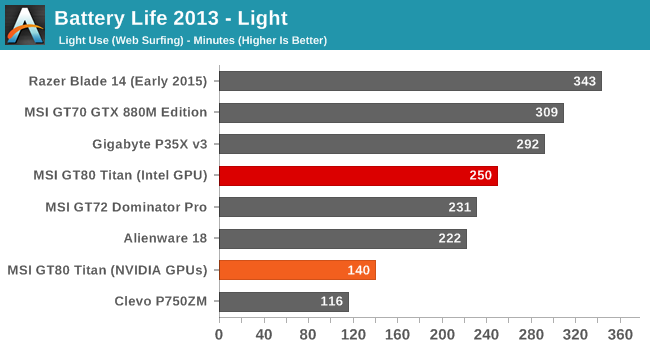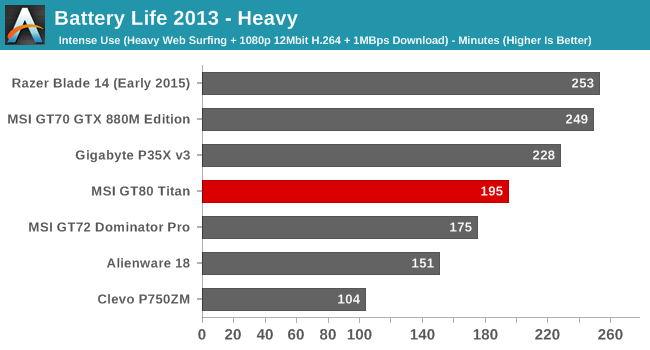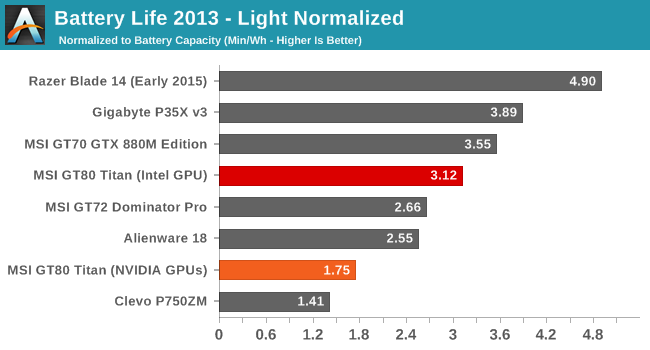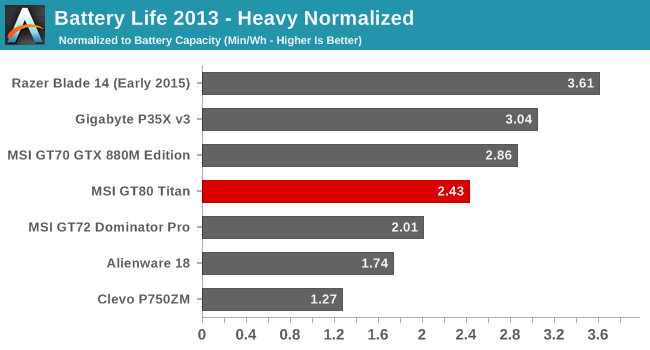The MSI GT80 Titan Review: The Broadwell Gaming Laptop Your Desktop Envies
by Brett Howse on June 26, 2015 8:00 AM ESTBattery Life
Normally on a notebook review, I would consider battery life to be one of the key aspects of the experience. However the GT80 Titan is not a typical notebook. This is really a device designed to sit on a desk and be used in lieu of a desktop computer. But if you ever feel the need to pick up this 10 pound laptop and lug it to the coffee shop, I suppose we should see what kind of battery life you can expect.
The GT80 Titan lacks NVIDIA’s Optimus technology, so it can’t switch from the discrete graphics to integrated graphics on the fly. MSI has included a hardware switch to change to integrated graphics, but it does require a reboot in between. Just to see how much of a difference this makes, I ran the light test first with the GTX 980Ms active, and then again leveraging Intel’s integrated GPU.

Our light test is light web browsing with the display set at 200 nits. The 80 Wh battery inside the GT80 Titan is really no match for the hunger of the SLI graphics cards, and with those enabled the battery life is a mere two hours and twenty minutes. However once you disable the GPUs and switch to the integrated GPU, the result is actually a pretty respectable four hours and nine minutes. Considering the size of the display and the power underneath the covers, I was actually shocked it was that high.

The heavy test ramps up the amount of pages browsed, adds in a 1 MB/s file download, and a movie is played back using the Windows 8 Video app. On most devices, the light test result is often dictated by the display power, and the heavy test shifts that balance over to the CPU and I/O. However with the power hungry components in the GT80, the difference between the light and heavy tests results is less than normal with it getting just about an hour less overall. Even though it is just three hours fifteen minutes, it actually ties the Sony Vaio Haswell based Ultrabook in this test, but it does have over double the battery capacity of that much smaller notebook.


Looking at the normalized graphs, the GT80 shows just how much energy is needed to power the CPU and large display. Once you turn on the GPUs though, the power usage really gets ugly and the light result with the GPUs enabled is one of the worst we have seen. Even though NVIDIA has been improving power efficiency and idle draw of their GPUs, they still are not in the same league as the 14nm Intel GPU when discussing minimum power draw.
Charge Time
In order to provide enough power for the two GPUs plus the quad-core CPU, MSI ships the GT80 Titan with a massive 330 watt A/C adapter. This power brick alone weighs more than some notebooks, but it is necessary to keep up with the insane power requirements of this notebook. With that much power available, MSI could have chosen to reduce the charge time pretty substantially.

Looking at the time though, the GT80 charges in roughly the same time as most notebooks. Even though they could have provided more power to the battery, this may have required beefed up circuitry, and even if that is there, it can be hard on the battery due to the heat generated. MSI was fairly conservative here but the end result is a fine 2.5 hours.










103 Comments
View All Comments
EzioAs - Friday, June 26, 2015 - link
I'm surprised to see the temperature and cooling of this notebook. I thought all gaming notebooks with high-end GPUs had inadequate cooling, thus leads to high temps. Clearly, I'm wrong here.Nice tongue twister on the intro btw.
Refuge - Friday, June 26, 2015 - link
I would hope with how much extra room they have over other things like the P35x that there wouldn't be heat issues.der - Friday, June 26, 2015 - link
20th comment!extide - Friday, June 26, 2015 - link
Nah most high end gaming laptops like this, alienware, or clevos have pretty good cooling. Essentially you want a dedicated fan for the CPU and another one for the GPU (or two, in this case, for the two gpu's)extide - Friday, June 26, 2015 - link
Although, this one cools the CPU with the 2 GPU fans, which should be fine, it's generally the GPU that you need to worry about overheating anyways.WinterCharm - Friday, June 26, 2015 - link
More important than dedicated fans is the actual layout and capacity of the heat pipes and heat sinks.Also some of the cheaper/worst designs are ones that put the CPU and GPU on the same heat pipes, as this often leads to throttling when both components are running at full bore.
extide - Friday, June 26, 2015 - link
Yeah, but those are ones where the cpu and gpu share a single small fan, this one shares the cpu across both gpu fans, which are suitably large.nerd1 - Saturday, July 4, 2015 - link
Very few applications taxes both CPU and GPU hard so shared heat pipes actually makes sense.Notmyusualid - Friday, June 26, 2015 - link
As an owner of an M18x R2 (i7 Extreme), and a few other notebooks, I can say that the shared-cooling solution is much better.Some games are more GPU-heavy, some CPU-heavy, and that goes for other workloads too. Sharing the cooling across multiple devices may help you achieve better performance in the long run.
Out of interest, I will, at some point link up all three fans in my Alienware when time allows, but only when my warranty expires.
WinterCharm - Friday, June 26, 2015 - link
A lot of better designed notebooks do not have cooling issues. Of course you pay a premium for them, but you get what you pay for in this case.